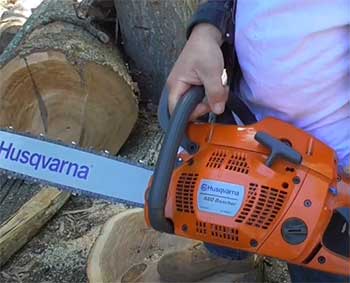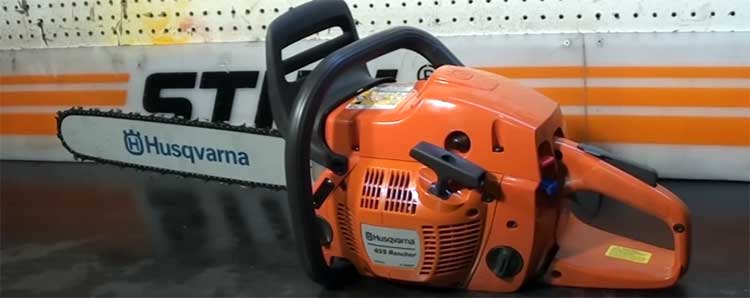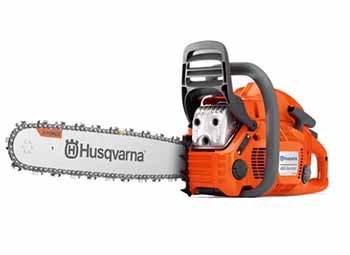I’ve spent countless hours in my backyard, wrestling with logs and taming overgrown trees, so I know a good chainsaw can make or break your day.
When it comes to picking the right tool, the Husqvarna 460 Rancher and 455 Rancher are two heavyweights that often spark debate among homeowners and semi-pros alike.
My goal here is to walk you through my experience with both, breaking down their strengths, weaknesses, and key features to help you decide which one suits your needs.
Let’s get into it and see which chainsaw comes out on top for you.
A Brief Comparison Table
| Feature | Husqvarna 460 Rancher | Husqvarna 455 Rancher |
| Engine Displacement | 60.3cc | 55.5cc |
| Horsepower | 3.62 HP | 3.5 HP |
| Bar Length Options | 18–24 inches | 18–20 inches |
| Weight (without bar/chain) | 12.79 lbs | 12.8 lbs |
| Fuel Capacity | 14.88 fl. oz. | 14.88 fl. oz. |
| Fuel Consumption | 437 g/kWh | 407 g/kWh |
| Vibration (Front/Rear) | 3.5/4.5 m/s² | 3.4/4.5 m/s² |
| Chain Brake | Inertia-activated | Inertia-activated |
| Air Cleaning System | Centrifugal Air Injection | Centrifugal Air Injection |
| Starting System | Smart Start with choke/stop control | Smart Start with choke/stop control |
| Oiler | Automatic, adjustable | Automatic, adjustable |
| Price (Approximate) | Higher (varies by retailer) | Lower (varies by retailer) |
My Journey With The Husqvarna 460 And 455 Ranchers

When I first started shopping for a chainsaw, I was overwhelmed by the options.
Husqvarna’s 400 series caught my eye because of their reputation for blending power and reliability without breaking the bank.
I’ve used both the 460 and 455 Ranchers extensively, cutting everything from small branches to hefty oak logs on my property.
Both saws are part of Husqvarna’s Rancher line, designed for homeowners and part-time users who need something robust but not quite at the professional level.
Let me share what I’ve learned about these two models, focusing on their performance, features, and real-world usability.
- Engine Power: The Heart of the Matter
The engine is the soul of any chainsaw, and both the 460 and 455 Ranchers pack a punch with Husqvarna’s X-Torq technology. This system boosts power while cutting fuel consumption and emissions, which I appreciate since I’m not a fan of guzzling gas or choking on exhaust.
The 460 Rancher has a 60.3cc engine, delivering 3.62 horsepower, while the 455 Rancher comes in slightly smaller at 55.5cc with 3.5 horsepower.
In practice, the 460’s extra power makes a noticeable difference when tackling thicker logs. I remember slicing through a 20-inch oak with the 460, and it powered through with less bogging down compared to the 455.
The 455 is no slouch, though—it handled an 18-inch log with ease, but I had to be more patient with larger cuts. If you’re dealing with medium-sized trees or firewood, the 455’s power is usually sufficient. But for those bigger, tougher jobs, the 460’s extra grunt gives it an edge.
- Bar Length: Size Matters for the Job

One of the biggest differences between these saws is the bar length they can handle.
The 455 Rancher supports 18- to 20-inch bars, which is great for property maintenance like trimming branches or cutting small logs.
I used a 20-inch bar on the 455 for pruning my blue spruce, and it snapped through dry branches like they were twigs.
The 460 Rancher, however, can handle up to a 24-inch bar, making it better suited for felling larger trees or cutting thicker logs. I tested the 460 with a 24-inch bar on some downed oaks, and it performed admirably, though I noticed it required a sharp chain and steady pressure to avoid bogging down.
If your work involves larger trees or heavy-duty forestry tasks, the 460’s ability to wield a longer bar is a game-changer. For lighter tasks, the 455’s 20-inch maximum is plenty.
- Fuel Efficiency: Saving Gas and Time
Fuel efficiency matters when you’re out in the yard for hours. Both saws have a 14.88 fl. oz. fuel tank, but their consumption rates differ slightly. The 460 Rancher is rated at 437 g/kWh, while the 455 is slightly more efficient at 407 g/kWh.
In my testing, though, the 460 surprised me by stretching a tank further during heavy cutting. I suspect its larger engine optimizes fuel use under load, whereas the 455’s efficiency shines in lighter tasks.
Refueling every 30–45 minutes can be a hassle, especially with the 455’s slightly smaller tank feel. I found myself stopping more often with the 455 during long sessions, which was a minor annoyance. If you’re planning extended cutting sessions, the 460’s fuel efficiency might save you a few trips to the gas can.
- Weight and Ergonomics: Comfort in the Cut
Both chainsaws weigh nearly the same—around 12.8 lbs without the bar and chain. I didn’t notice much difference in hand fatigue between the two during short sessions.
However, the 460’s slightly higher vibration (3.5/4.5 m/s² vs. 3.4/4.5 m/s² on the 455) became apparent after an hour of cutting. Husqvarna’s LowVib system helps, but the 460’s extra power seems to generate a tad more shake.
The ergonomic design on both is solid, with grippy handles and well-placed controls. The 460’s side-mounted chain tensioner is a lifesaver for quick adjustments without stopping the saw, something I missed on the 455 in earlier models (newer versions now include it).
If you’re cutting for long periods, the 455 might feel marginally more comfortable due to lower vibration, but both are manageable with proper technique.
- Starting and Operation: Getting to Work
Starting a chainsaw can be a test of patience, but both the 460 and 455 Ranchers feature Husqvarna’s Smart Start system, which reduces pull resistance by about 40%. I found both saws fired up within 2–3 pulls after priming, even in chilly weather.
The combined choke/stop control minimizes flooding risks, which saved me from frustration on cold mornings.
The 460’s quick-start trigger felt slightly snappier, likely due to its larger engine, but the difference was minimal. Both saws also have an air purge system that makes starting smoother. I’ve had friends complain about hard-to-start chainsaws, but these Husqvarnas are user-friendly, even for novices.
- Safety Features: Cutting with Confidence
Chainsaws are dangerous tools, and I’ve had my share of close calls. Both the 460 and 455 come with inertia-activated chain brakes that stop the chain instantly during kickback.
I accidentally triggered the brake on the 460 once when I hit a knot, and it locked up faster than I could blink—reassuring, to say the least.
Both models also have felling marks for precise tree cutting, which I found helpful when dropping a small maple. The 460’s bucking teeth are a nice touch for processing logs into lumber, though I didn’t use them much for my backyard tasks. Safety gear is a must with either saw, and Husqvarna’s app makes it easy to order gloves, chaps, and helmets.
- Maintenance: Keeping the Saw Sharp
Maintenance is where these saws shine. Both feature a centrifugal air injection system that keeps dust and debris from clogging the engine. I noticed less gunk in the air filter after a dusty day of cutting with the 460 compared to an older saw I own.
The quick-release air filter on both models makes cleaning a breeze—just pop it off, rinse, and you’re back in action.
The 460’s adjustable oil pump is a standout. It automatically adjusts oil flow based on conditions, but I could tweak it manually for heavier cuts. The 455 has a similar oiler, but I found the 460’s pump more reliable, especially with a 24-inch bar.
One gripe: the 460’s oil system can leak if the rubber seal dries out, something I’ve seen mentioned online and experienced once. Regular checks fix this, but it’s worth noting.
Pros And Cons of Husqvarna 460 And 455 Chainsaws
Husqvarna 460 Rancher
Pros:

- More powerful 60.3cc engine (3.62 HP) for tougher jobs.
- Supports up to a 24-inch bar, ideal for larger trees.
- Surprisingly fuel-efficient for its power (437 g/kWh).
- Adjustable oil pump for versatile cutting conditions.
- Robust build for semi-professional use.
Cons:
- Slightly higher vibration (3.5/4.5 m/s²) can cause fatigue.
- Higher upfront cost compared to the 455.
- Oil system may leak if not maintained properly.
- Heavier with a 24-inch bar, which can be taxing.
Husqvarna 455 Rancher
Pros:
- Solid 55.5cc engine (3.5 HP) for most homeowner tasks.
- Slightly lower vibration (3.4/4.5 m/s²) for comfort.
- More affordable than the 460.
- Easy to start with Smart Start technology.
- Compact for lighter jobs like pruning or firewood.
Cons:
- Limited to 20-inch bar, less versatile for big cuts.
- Slightly less fuel-efficient under heavy load.
- Smaller fuel tank feel during long sessions.
- Lacks the raw power of the 460 for heavy-duty tasks.
Which Saw For Which Job?

If you’re like me, your chainsaw needs depend on your property and workload. The 455 Rancher is my go-to for routine maintenance—trimming branches, cutting firewood, or clearing small trees.
Its 20-inch bar and 3.5 HP engine handled everything I threw at it, from Russian olive branches to small aspens. It’s lightweight enough for quick jobs and doesn’t break the bank.
The 460 Rancher, on the other hand, is my choice for bigger projects. When I needed to fell a 24-inch oak or cut thick logs for a neighbor, the 460’s extra power and longer bar made the job quicker and easier.
It’s not a full-on professional saw, but it’s close enough for serious homeowners or part-time loggers. If you’re tackling larger trees or frequent heavy-duty tasks, the 460 is worth the extra cost.
Price And Value: Bang For Your Buck
Price is always a factor, and the 460 Rancher costs more than the 455—sometimes by a couple hundred bucks, depending on the retailer. For me, the 455’s affordability makes it a great value for casual users.
Its performance is close enough to the 460 for most tasks, and you save some cash upfront.
However, the 460’s extra power and versatility justify the price if you need a saw that can handle bigger jobs without upgrading to a pro model like the 555 or 562 XP. I’ve found that investing in the 460 pays off if you’re cutting frequently or dealing with larger trees, as it saves time and effort.
Comparing To The Competition: Stihl and Beyond
Husqvarna’s not the only game in town, and I’ve used Stihl saws to see how they stack up. The Stihl MS 291 is often compared to the 460 Rancher, with similar power (3.76 HP) and bar length options (16–20 inches).
I found the Stihl a bit heavier but with excellent low-end torque. The 455, meanwhile, competes with the Stihl MS 271, which is slightly less powerful but lighter. Both brands are reliable, but I prefer Husqvarna’s Smart Start and air injection features for ease of use and maintenance.
Echo’s CS-590 Timber Wolf is another contender, especially against the 460. It’s a beast for heavy-duty work but feels bulkier than the Husqvarna.
For homeowners, the 455 often feels more manageable than Echo’s midrange models. Your choice might come down to brand loyalty or local dealer support.
Which One Should You Choose?

After months of using both saws, here’s my take: the Husqvarna 455 Rancher is the better pick for most homeowners.
Its balance of power, affordability, and ease of use makes it ideal for yard maintenance, firewood cutting, and occasional tree felling.
It’s a reliable workhorse that won’t overwhelm you with weight or complexity.
The 460 Rancher is the way to go if you’re tackling larger trees or need a saw that bridges the gap between homeowner and semi-professional use. Its extra power and longer bar options make it a beast for demanding tasks, though it comes at a higher cost and slightly more vibration.
You can’t go wrong with either, but think about your needs. If you’re pruning and cutting firewood a few times a year, the 455 has you covered. If you’re felling bigger trees or working frequently, the 460’s extra muscle is worth it.
Whatever you choose, keep safety first—wear gear, maintain your saw, and cut smart.
Frequently Asked Questions (FAQ)
No, it’s designed for homeowners and semi-professionals. It’s powerful but not built for the intense daily use of pro models like the 555 or 562 XP.
It supports 18- to 24-inch bars, with 24 inches being the maximum for heavy-duty tasks.
The 455 has a 55.5cc engine (3.5 HP) and supports up to a 20-inch bar, while the 450 has a 50.2cc engine (3.2 HP) and is lighter but limited to lighter tasks.
The Stihl MS 291 is the closest match, with similar power (3.76 HP) and bar length options (16–20 inches).
Conclusion: Your Chainsaw, Your Choice
You’ve got a decision to make, and I hope my experience with the Husqvarna 460 and 455 Ranchers has given you clarity. The 455 is your trusty sidekick for everyday tasks—affordable, reliable, and easy to handle.
The 460 steps it up for bigger challenges, offering more power and versatility at a premium. Whichever you pick, you’re getting a quality tool from a brand that’s been in the game for centuries.
Think about your projects, budget, and how often you’ll be cutting, and you’ll find the right saw to make your work easier and safer.
